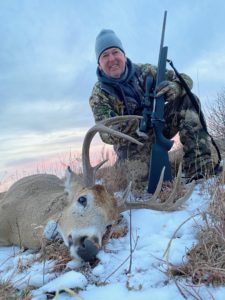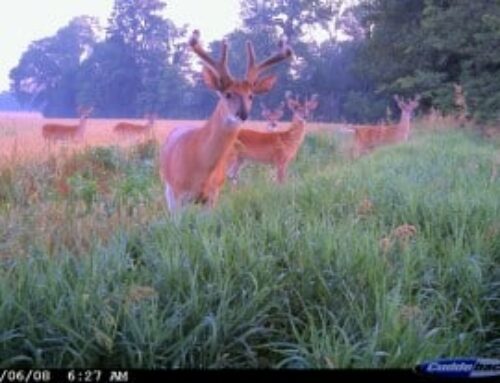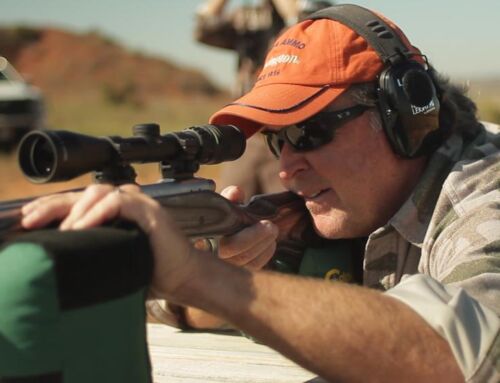Skip to content
Deer Gun Hunting: 8 Tips To Make One Shot Count
 When a deer is quartering away from you, aim for the heart/lung vitals behind the shoulder you can see, then slide the scope’s crosshair back, pin it on the ribs and press the trigger. The harder a buck is quartering away, the farther back you aim on the ribcage—6 inches to 8 inches to even a foot. The physics is for the bullet to punch through the deer’s ribs, angle forward through the lungs/heart and either lodge in the opposite side front shoulder or exit it.
When a deer is quartering away from you, aim for the heart/lung vitals behind the shoulder you can see, then slide the scope’s crosshair back, pin it on the ribs and press the trigger. The harder a buck is quartering away, the farther back you aim on the ribcage—6 inches to 8 inches to even a foot. The physics is for the bullet to punch through the deer’s ribs, angle forward through the lungs/heart and either lodge in the opposite side front shoulder or exit it.- Think out a shot before it happens. Say you’re stalking on a ridge: What if a buck jumps out of that draw? Which way will he run? Is it 150 or 200 yards across that canyon? Stay sharp and try to foresee a quick shot as best you can. One October day I crawled up on a buck browsing in the shade, zapped him at 152 yards with my range finder, flipped down the legs of my rifle’s bipod, aimed for 10 seconds and pressed the trigger. It was like shooting that deer off a bench rest. Use a flip-down bipod that attaches to your rifle in big, low-grass country where you have time to go prone and set up a shot. There is no better rest. When still-hunting in timber or taller cover where a buck might pop up quickly, the side of a tree or a monopod is a better option.
- Hunters blow untold numbers of shot opportunities by fiddling around with a rest as a buck gets away. At home before the hunt, practice flipping, extending and locking the legs of a new bipod or sticks, until you can set up and be ready for a one-kill shot in seconds.
- In the mental chaos of trying to shoot a 10-pointer, who can remember some fancy wind-doping equation? Here’s all you need to know. If the wind’s blowing 5 to 15 mph hold dead-on a buck. But if you’re having trouble keeping your cap on your head, use your gut instinct and hold into the wind on shots past 150 yards.
- One time out in the Red Hills of western Oklahoma, I scooted up a ridge, set down my shooting stick and fired at an 8-pointer 140 yards away. “Shot over him!” squealed my friend Scott as we watched the buck walk nonchalantly away. To this day I cringe and remember why I blew it. The ridge was steep and rocky, and I was forced to set up on a rough downhill slope. I contorted and scrunched down, rifle barrel wobbling all around. I rushed it and shot before I was ready, and that is one of the main reasons we screw up. Once in a blue moon after a miss, a disoriented buck will turn and walk straight back to you, like that Oklahoma buck did that day. Count your blessings, lock in, breath and take him with a second perfect bullet.
- If a buck is walking toward you, quartering slightly on, aim the crosshair onto the point of the shoulder you can see. Hit a deer squarely on the mid-point of the shoulder with a stout bullet that drives back through the vitals, and the animal almost always thumps straight down.
- When is the last time you shot underneath a buck? “By far most misses are high,” says Wyoming outfitter Brian Beisher. He notes that most hunters, especially those from back East that come West for mule deer, instinctively aim too high, even when a buck is only 120 to 200 yards away. Beisher tells his hunters to calm down and “aim for the heart, aim for the heart. It helps them pull their shots low into a deer’s chest.”
- Old advice is still good advice: Once you’ve decided to shoot a buck, don’t look at that big pretty rack again. Take a deep breath, focus on a patch of brown hide low behind his shoulder, pin the scope’s crosshair there and take him with one perfect bullet.
Page load link
 When a deer is quartering away from you, aim for the heart/lung vitals behind the shoulder you can see, then slide the scope’s crosshair back, pin it on the ribs and press the trigger. The harder a buck is quartering away, the farther back you aim on the ribcage—6 inches to 8 inches to even a foot. The physics is for the bullet to punch through the deer’s ribs, angle forward through the lungs/heart and either lodge in the opposite side front shoulder or exit it.
When a deer is quartering away from you, aim for the heart/lung vitals behind the shoulder you can see, then slide the scope’s crosshair back, pin it on the ribs and press the trigger. The harder a buck is quartering away, the farther back you aim on the ribcage—6 inches to 8 inches to even a foot. The physics is for the bullet to punch through the deer’s ribs, angle forward through the lungs/heart and either lodge in the opposite side front shoulder or exit it.




